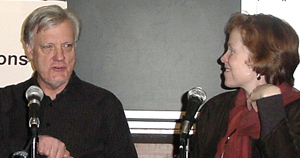| Remixing Shakespeare |
|||
|
New technologies are enabling forms of borrowing, appropriation and "remixing" of media materials in exciting, provocative ways. But many creators and observers of such work assume the practice is brand new, a unique feature of our digital culture. The truth is that the act of seizing upon and repurposing artistic materials belonging to others is as old as art itself. The history of the use and appropriation of Shakespeare is an especially instructive instance of this eternal (and necessary) cultural process. In this Forum two MIT scholars who have studied and written about Speakers Diana Henderson is professor of Literature and author of Collaborations with the Past: Reshaping Shakespeare Across Time and Media; A Concise Companion to Shakespeare on Screen and Passion Made Public: Elizabethan Lyric, Gender and Performance. She is an active participant in MIT's partnership with the Royal Shakespeare Company. Moderator: Literature Professor Mary C. Fuller works on the history of early modern voyages, exploration, and colonization. Her teaching interests range from the great works of Renaissance poetry (Paradise Lost, the Faerie Queene) to the intellectual and practical aftermaths of Europe's encounter with America in the 15th century and beyond. She is the author of Voyages in Print: English Travel to America: 1576-1624. A podcast of Remixing Shakespeare is now available from Comparative Media Studies. A webcast of Remixing Shakespeare is now available from MIT World. Summary (this forum was also covered by MIT Tech Talk ) by Greg Peverill-Conti and Marie Thibault
Diana Henderson began by addressing the contemporary roots and origins of remixing Shakespeare. To her, the idea of remixing Shakespeare is not as new as some may think. While the application of digital technology is new, from the artist's perspective, borrowing and mixing across mediums has been happening for a very long time. Few artists limit themselves to just one domain and Shakespeare certainly didn't. He wrote lyric poems, narrative poems, and works for the stage as did his contemporaries. There was a remarkable amount of crossover and convergence among the different art forms of the time. Beyond the mixing and merging that was going on, the nature of many of the arts in particular the visual arts was undergoing change during Shakespeare's day. Theater, from its beginning, was a collaborative art form. Shakespeare was working at a point in time when people would rewrite one's work. This was the case with Mittleton's addition of the Hecate speech to Macbeth after Shakespeare retired to Stratford. During The Restoration, when Shakespeare had been dead for about 50 years and had been monumentalized to some extent, people felt they needed to keep him in the repertory, but only with extensive rewriting. A famous example of this is the rewriting by Tate of a happy ending to King Lear, in which the king gets the throne and Edwin and Cordelia have a romantic relationship. In this case, the rewritten text speaks to a generation that has just lived through a usurpation of the throne or the killing of the king, but how can we explain the fact that for the next 150 years people continued to perform Tate's Lear instead of Shakespeare's? It wasn't as though they weren't aware of the original version since it continued to be available in print, or that they continued to worry about the fate of the King. Yet it wasn't until 1837 that Charles Macready put the original ending back on stage. The Restoration also saw the addition of song and dance to Shakespeare's work. Macbeth as a musical seems strange to us today, but it really isn't that different from Othello as an opera. [A clip is shown] Throughout the filmed version of the opera people can be seen looking in, looking through, consciously observing and spying which ties to those themes in the text of the play. But is this still Shakespeare? If it isn't the actual language can it still be Shakespeare? Is it still Shakespeare if you modify so many dimensions of the story? Most of us would say yes, even though we aren't likely to be as charitable with some of the earlier remixes. Can it still be Shakespeare if you don't have sound or words just title cards? The ability to remix Shakespeare across time, medium, and culture is one of the reasons he has remained so relevant and important. [Shows clip from silent-film version of Othello] The exaggerated acting style of Emil Jannings in the clip is very pronounced and the plot line has been altered for the film version. His power and authenticity in the role, however, can't be appreciated with a single clip out of context. It was no accident that he won the first two Academy Awards for Best Actor. This version also needs to be considered in its historical context and not simply in the moment it was made (which is evident in its rich examples of German expressionist film making); but also in the 100 years of telling, retelling, and adapting the Othello story that had preceded it. Another sense of remix that appears in both of the clips is the use of blackface. To talk about remix only in terms of the form is inadequate. The socio-political dimension of remixing also has to be considered. The use of blackface in the 19 th century a time of slavery was very different than its use in Shakespeare's day. There is also the celebrity remix [a still of Liz [Elizabeth Taylor] and Dick [Richard Burton] in the Taming of the Shrew is shown on the screen]. The film in this case was produced, in part, to help promote the careers of the two of the more romantically amusing stars of their day which is yet another use of remixing; and one that combines elements of the on-screen and off-screen worlds. Another example of mixing is the use of different genres to support a story. The four centuries since Shakespeare's day has allowed reflection and consideration that has allowed the various remixing we see today. [A clip from Campbell Scott's Hamlet is shown] This version of Hamlet uses horror film sensibilities and conventions to tell and support the story even though it doesn't use all of the words or staging of the original. Some may feel that something is lost when Shakespeare is moved to the screen because the language needs to be adapted but as was the case with this clip, the medium of film opens up new story-telling opportunities. All of this points to the malleability of Shakespeare and the ability of the artists to provide input and context whether they know it or not. It is easy to look at a performance and see and discuss how it is informed and influenced by previous performances even if the performers are not aware of the connections. The final clip that Henderson showed which included no lines from the original Shakespeare was very consciously playing with Shakespeare. John Cassavetes plays a version of a Prospero figure and Raul Julia is playing Talibanos, a cynical disaffected New Yorker who has become a local shepherd. The clip features a dancing Julia playing New York , New York (as Liza Minelli sings) to his flock. Henderson cites this as one of the best examples of the blur between Diogenic and non-Diogenic sound that there is. This clip does an excellent job of catching the spirit of Caliban wanting to once again become the master of the world. It does it in a way that makes the film fun to watch and while there are no lines from Shakespeare, there can be a lot of virtue in impurity.
Peter Donaldson began by asking whether there was remixing in Shakespeare's work itself, not simply in an occasional sense but in a disciplined and sustained way. Shakespeare himself did borrow from multiple source materials, but it isn't clear how conscious it was in his case or if it was simply the case of his absorbing and reusing content and context that he came across organically. It seems unlikely that he was consciously mixing things in a tiered or layered way. The closest thing Donaldson was able to find was the use of the mask elements in the Tempest. Donaldson discussed three main points: whether or not Shakespeare himself remixed; examples of Shakespeare remixed from contemporary films, particularly Michael Almereyda's Hamlet ; and examples of popularly created remixes that might be found on YouTube. Ethan Hawke plays a videographer in Almereyda's Hamlet . The film offers a literal interpretation of Hamlet on several levels. Hawke based his Hamlet in part on the life of Kurt Cobain, so it resonates with alienated youth culture. The film includes the lines of Hamlet ; but the video images Hawke chooses to illustrate those lines are more important than the lines themselves. The found video used throughout the film serves as a visual means for both the character and the filmmaker to visually reinterpret Shakespeare. The use of video as the main tool for Hawke to capture and experience the world - allows him to meditate on his life; but it also cuts him off from the world around him and illustrates his grief in a way that other versions do not. The video is also used to create a media narrative a personal narrative and personal medium; but it doesn't allow one to fully engage in the world and leads to a tragic close. But tragedy has its compensations. In this version, Hawke is working on a film of Mousetrap so instead of a play within a play we see a film within a film. However, in many ways that is less interesting than the informal content the character creates during the course of the film. One thing that many commentators missed in looking at the film was the tool that Hawke was using to create his video. It was a child's Pixelvision camera from the 1980s. This media choice marked the character as standing apart, as being introspective and as being alternative. The next clip featured Buddhist monk Tic Nat Han speaking on television while Hawke watched distractedly viewing his own videos, writing, and thinking. Han is talking about the idea of to be and interbe and the fact that to be means not being alone but to be connected with everything around you. To be or not to be is conveyed through a complicated interaction between the Han video and Hamlet. It includes the videos he is watching and the videos he is making in what Donaldson calls a multi-tasking meditation. He is viewing videos of the things he is thinking about and this is increasingly becoming a serious means of processing and meditating ideas like to be or not to be. The degrees of remixing occurring in this film is so involved and layered that to appreciate and understand it all requires that one stop the film and really study the images. This, of course, is made possible with the introduction of DVD and other digital video technologies, which demonstrates again how the context of a medium has allowed new interpretations and remixing of Shakespeare's work. We make a mistake if we view these films simply as popular works. They are learned works which, if nothing else, are able to draw on a much larger and longer tradition to convey deeper meanings. These remixes can only be recognized and interpreted with conscious effort and study. In the case of YouTube, the most popular remixes seem to be Romeo and Juliet often redone as a love poem for Valentine's Day. These often include sappy music and an explicit dedication to a specific person. Remixes of portions of Shakespeare in Love are also common. Another remix that Donaldson found on YouTube was a clip from a 1960s television program that featured The Beatles introducing Peter Sellers in the guise of Sir Laurence Olivier as Richard III, reciting the lyrics to A Hard Day's Night. This clip was included as almost a plea for authorship. There is so much talk about the dissolution of the role of the author or creator and yet in this clip there are four distinct voices that combine to create the work. In looking at the videos even the most amateur of them Donaldson is struck by a strong sense of craftsmanship of something having been created by a particular person to be a specific kind of work. What many of these videos demonstrate is a cultural and temporal compression a free borrowing and mixing and remixing of content and context that results in relevant images that are almost immediately available to be used themselves. He ended by suggesting that there is something different about the culture of remixing not that it didn't have historical precedents; and that it holds tremendous educational possibilities in the growing store of video that now exists. Discussion Question: If Shakespeare is a point on a continuum that includes the sources he drew on as well as the subsequent remixes, why do we insist on calling them remixes of Shakespeare rather than Verdi or Tate or the names of any of the other reinterpreters? Henderson: We do refer to Verdi's Othello as being his; at a very basic level, if the remix stands on its own and we like it, it is called by the remixer's name. When we don't think as highly of it we tend to view it as bastardized Shakespeare. It's partly a collective judgment of the quality of the work. Question: I have tickets next month to see the Worcester Group's remix of Hamlet. Can you talk about extreme remixes in the theater itself? Henderson: I think of Peter Sellars as the antithetical avant garde to the Worchester Group, in that he announces his socio-political engagements. When you think about theater broadly, when you say Romeo and Juliet, I think of West Side Story and the whole mainstream as well. People seek out theater and opera that offer a heightened and non-normative speech. In order to use Shakespeare's original language it needs to be presented in some alternative or non-normative way. The exception might be those attempts to recreate the Elizabethan stage experience; but those are more simulacra almost like going to Disneyland to see a non-authentic attempt to ignore the fact that you are in a different time and place and socio-political situation. Fuller: It's like going to Stratford-on-Avon, it just feels so fake.
Henderson: The town is just like one big Greetings from Stratford-on-Avon mug. Donaldson: When attempts are made to recast based on gender, but not in an attempt at historical recreation, the results can be very interesting. There have been fascinating remixes in that sense all-woman casts, all-bearded men productions, and so on. Henderson: The most extreme versions of this which we haven't touched on are the globalized versions that are real remixes that strive to sustain two things at once: the original story and the cultural context of the performance. There are many that question whether or not this works. An example is the South African production of Macbeth that combines the play with Zulu theater. What is most interesting in these cases are those points where the cultures don't mix and the fractures are most evident. Question: I wonder if you could expand on translation and transition of Shakespeare to other cultures and on your thoughts of preserving Shakespeare's language in contemporary culture. Henderson: I don't think this is category analysis where we can say one approach to applying language is better than another. One has to look at each case because it isn't all bad or good. Most of the characters in Shakespeare's plays were in contemporary dress or in some vague form of past dress. We live in a different age in terms of our view of history and it doesn't always work for us to see things in some vague sense of the past. Donaldson: We live within these professional shifting sands. Fifteen years ago people would have assumed that it couldn't be Shakespeare if the language wasn't there; and now we take almost the opposite view. Henderson: Today the most successful and popular remixes shift so much: time, culture, language everything. This may also say something about language-centric analysis. Donaldson: There is also something that applies here to the question of Shakespeare in foreign languages. One of the issues that is important is whether real dual culture literacy is needed to appreciate these versions. I've written about Throne of Blood , a Japanese film and I think the only non-English film I have written on; but I don't know if what I wrote is right. Kurosawa always insisted on a dual inspiration even insisting that Ran had nothing to do with King Lear . Of course he had to take that back. I think that one does need to have a true bi-cultural competence to truly understand this. Henderson: When one talks about these bi-cultural versions, one has to ask the questions, are they better for whom? The more one is tuned in to a certain loop of knowledge the more enjoyable it is going to be. We just try to bring out what is interesting. Question: Can we at least compare remixed versions? Donaldson: I think that we can look at these different films and see in them different thinking and different degrees of success based on the artists' visions. In a lot of ways stylistic breakthroughs may turn out to be as important as they might have been originally thought. Question: Have you had any thought of Shakespeare the video game? Where one is able to be Shakespeare, control the plot, be immersed in the experience. I played the Lord or the Rings games with my daughter and had a more immersive experience than I ever did reading them.
Henderson: One thing that I would point out is that in a Shakespeare game people don't necessarily want control; people who like the drama don't like the idea of there being a single controlling narrative voice or guiding hand even though they knowthere is a playwright behind the work. I'd argue that from the beginning Shakespeare wasn't the only body behind the works without the actors available to him at the time he wouldn't have been able to create the works that he did. You also need a history of parts that you can draw on to create the parts and characters that make up the Shakespeare play. One thing that we haven't touched on today is the role of liveness and the part that plays in the dimension of theatricality that works so well in Shakespeare. While Shakespeare works well on the screen we have certainly lost at least one of the key dimensions of his work. --photos by Greg Peverill-Conti and Marie Thibault
|
|||




